- Stat Significant
- Posts
- What Makes Star Wars Fandom So Unique? A Statistical Analysis of Entertainment's Ultimate Fanbase
What Makes Star Wars Fandom So Unique? A Statistical Analysis of Entertainment's Ultimate Fanbase
Exploring the facts and figures of Star Wars fandom.
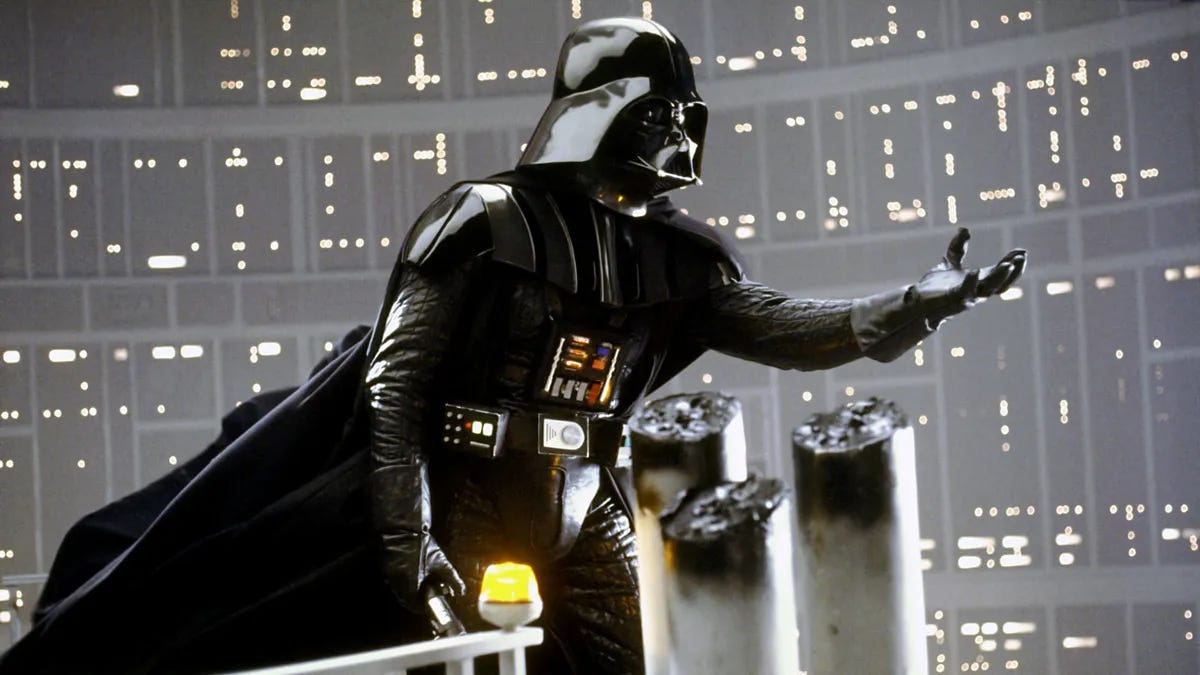
Star Wars: Episode V – The Empire Strikes Back (1980). Credit: 20th Century Studios.
Intro: (Arguably) The Most Consequential Deal in Hollywood History
In 1974, fresh off the breakthrough commercial and critical success of American Graffiti, director George Lucas set his sights on something rather untraditional for his next project—an epic space opera. American Graffiti had grossed over $140M off a budget of $770k, earning five Oscar nominations (including Best Picture), yet Lucas struggled to find backers for his new Sci-Fi epic. Paramount, Disney, Universal, and United Artists all passed on the project, citing concerns over the commercial potential of the Sci-Fi genre and Lucas' relative inexperience.
Determined to see his dream project greenlit, Lucas secured financing for Star Wars by making one of the most consequential business decisions in Hollywood history: He accepted a lower directing fee in exchange for retaining merchandising and sequel rights for the Star Wars franchise. Lucas cut his salary from $500k to $150k, and 20th Century Fox gave up rights to toy sales that were unlikely to exist (merchandising was not a significant revenue stream for studios in those days). 20th Century Fox's relinquishment of merchandising rights would go down as one of the most unfortunate business decisions in Hollywood history (and pretty much the history of any industry), as Star Wars has generated a mind-boggling $32B in merchandise sales to date.
Each year, an estimated $3B in Star Wars-licensed products are sold, and this figure is said to reach $5B to $7B in years coinciding with a Star Wars film release. Driven by a fanbase of unparalleled size and dedication, Star Wars is one of the few media properties that exists as an enterprise unto itself, boasting an entire section of Disneyland, an unofficial holiday (May 4th), standalone Star Wars conventions, an endless parade of streaming series, $200 customizable light sabers, and pretty much anything else a fan could want.
In a modern entertainment industry built upon the patronage of steadfast fandoms,Star Wars is Hollywood's most lucrative and reliable franchise—a cherished cultural gem that has remained a mainstream phenomenon for over 50 years. So today, we'll explore the uniqueness of Star Wars fanhood, the incredible commercial footprint of this devoted fanbase, and whether Hollywood's most formidable brand is losing its luster.
The Uniqueness of Star Wars Fandom
As children exit toddlerhood, parents face a crucial decision of the utmost existential importance: what is the first movie to show my kids (that they'll actually remember)? For my father, the answer was Star Wars. After dropping my sister at Sunday school, we'd drive to a nearby theater to watch the original Star Wars trilogy on the big screen.
My earliest moviegoing memories involve sitting in DC's gigantic Uptown Theater watching Star Wars: A New Hope and Return of the Jedi. My dad likes to remind me of these outings, a catalyst for my lifelong infatuation with movies and a relentlessly nostalgic moment of father-son bonding (much like watching Field of Dreams and having a catch).
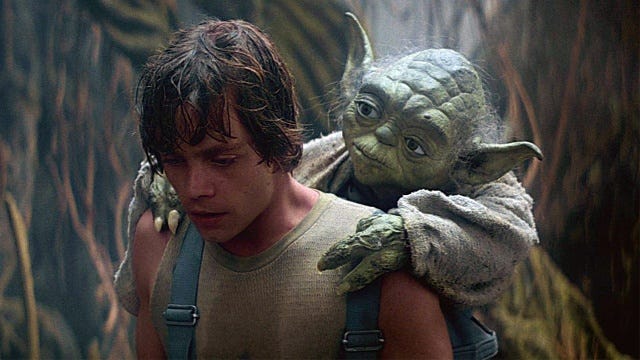
Star Wars: Episode V – The Empire Strikes Back (1980). Credit: 20th Century Studios.
Present day, I now understand this experience to be an odd combination of intimate and universal: watching Star Wars in early adolescence, as passed down by your parents, is both a highly personal formative experience and extremely common. In an online poll of over 5,100 self-identified Star Wars fans, the median age of first viewing was six years old, with 90% of respondents having watched a franchise installment before the age of 13.
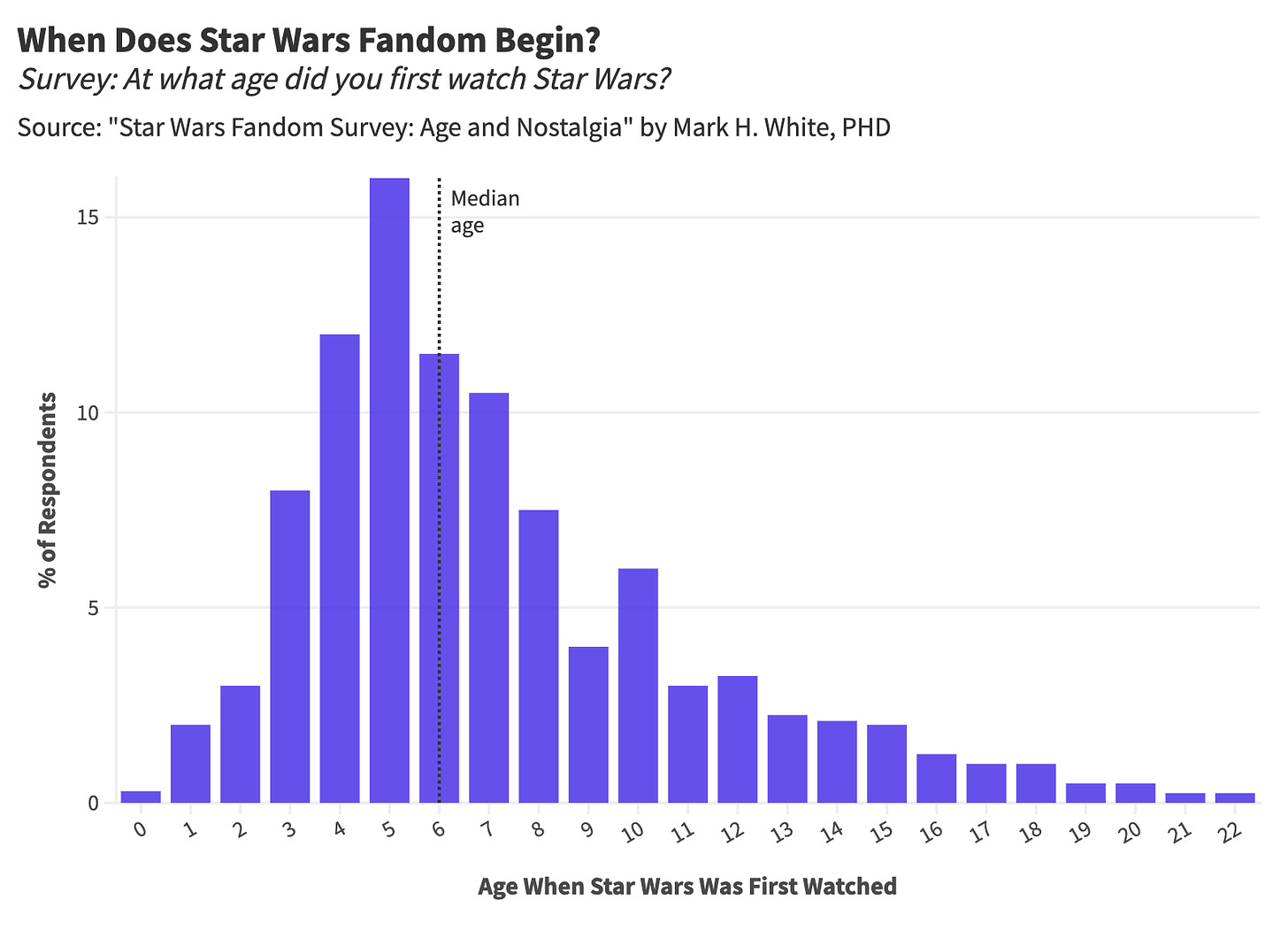
For my generation (and perhaps all generations), Star Wars exists as a developmental milestone of sorts, which is odd for films with several frightening sequences (like the trash compactor or Jabba the Hutt). For many (or most) fans, loving this franchise is indelibly linked to childhood nostalgia and familial bonding.
Inadvertently, Star Wars pioneered the model for modern fandom by hooking kids early and crafting universal stories that encourage lifelong loyalty. In a 2015 YouGov poll of 1,000 Americans, 75% of respondents considered Star Wars to be "for everyone"—a cultural keepsake for all generations. Similarly, a 2019 survey of over 145k respondents found Star Wars fandom to be equally prevalent across various generations and geographies. Amazingly, Baby Boomers and Gen Z are equally likely to identify as Star Wars fans—an area of common ground between two wildly different cohorts.
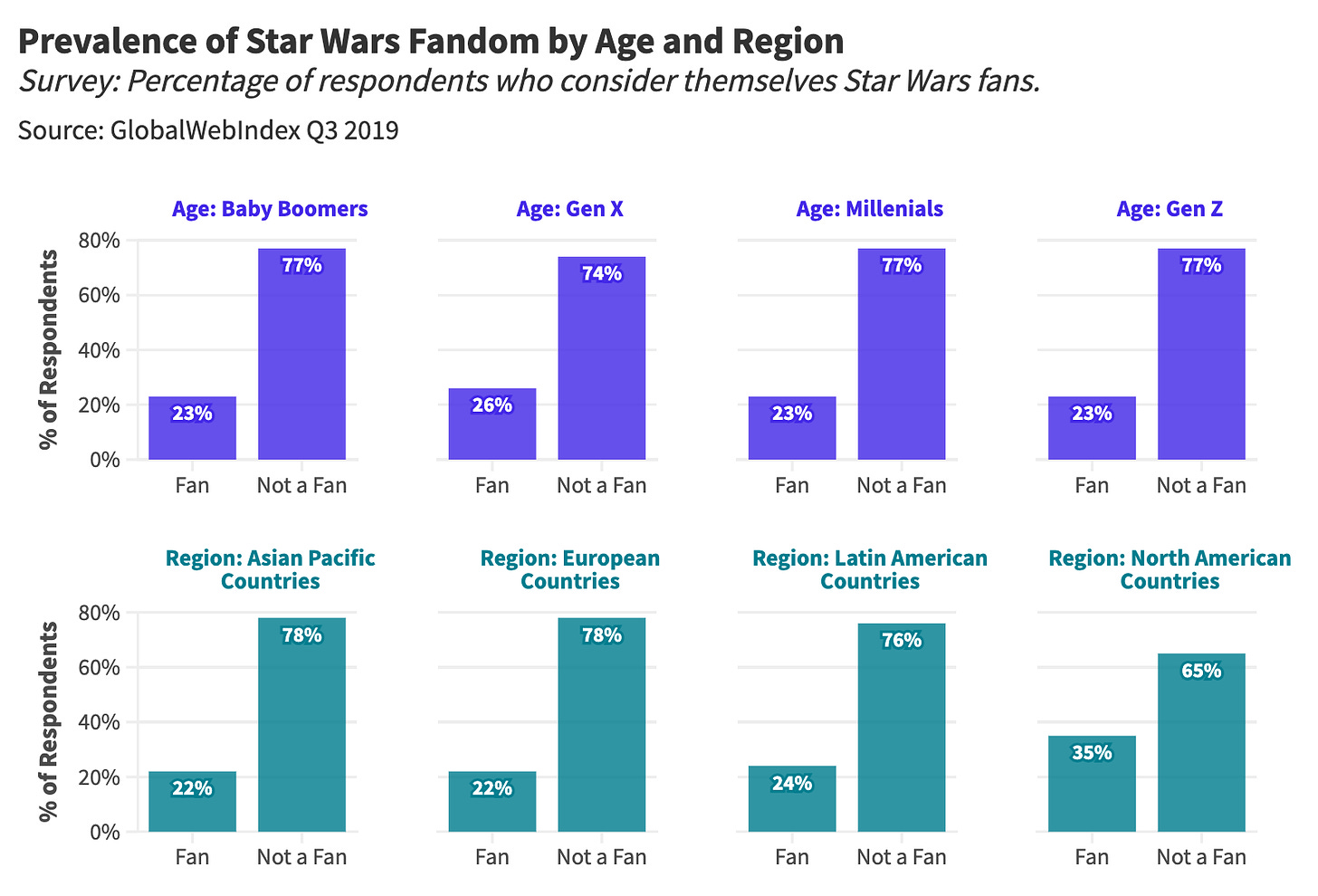
Star Wars fandom is slightly higher in North America than in other countries, though the franchise maintains a considerable global footprint. Is Marvel this popular in Asian Pacific countries? Does the DC Extended Universe covet such affinity from Baby Boomers? My best guess is no. For better (or worse?), Star Wars has maintained relevancy for nearly five decades—a feat only matched by Dr. Who, Saturday Night Live, and Dolly Parton.
Another fascinating aspect of the Star Wars fanbase is their unprecedented level of engagement. A survey of over five thousand fans found that most devotees regularly consume news on franchise developments, own collectibles, watch cartoon adaptations, read world-building novels, and play Star Wars video games.
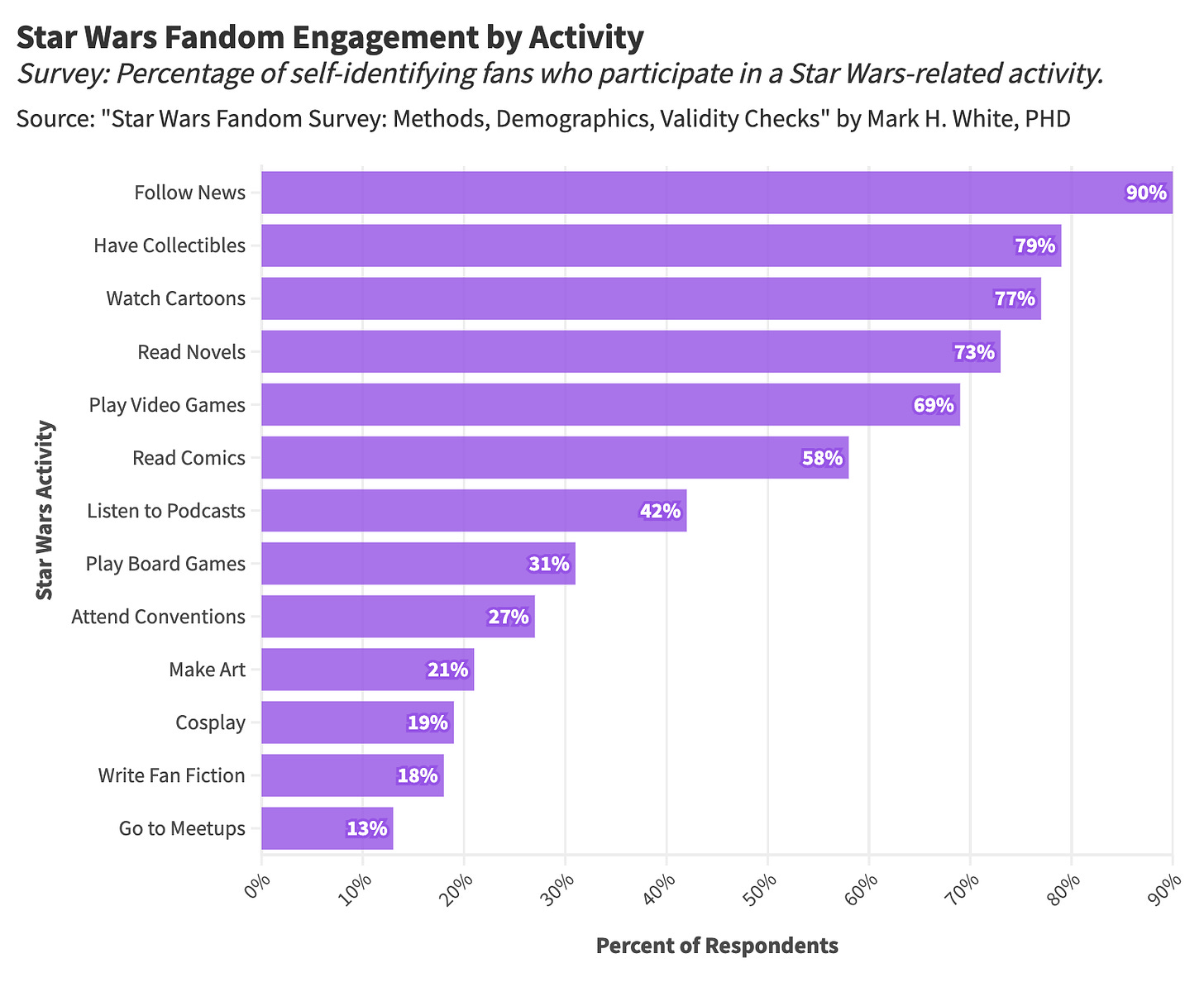
Here lies the agony and ecstasy of the Star Wars franchise: fans love engaging with this cinematic universe across myriad mediums and products, and this valorization often leads to buying stuff. In isolation, there is nothing wrong with spending money on something you love, that is, until the buying power of your fandom is quantified (by someone in corporate America). Over the past thirty years, Hollywood has become increasingly risk-averse, demanding greater returns while avoiding downside risk exposure. As such, movie studios have increasingly relied on established fandoms, adapting beloved stories that come with built-in audiences, like Marvel and Harry Potter. And which fandom is the most valuable of them all? Star Wars.
Consider this 2024 study of Amazon buying habits on May 4th, better known as "Star Wars Day." For those unfamiliar, May 4th sounds like "May the force be with you" and has become an internet holiday marked by conspicuous consumption—much like Amazon Prime Day. Every year on May 4th, fans flock to the interwebs to further their love of this beloved franchise (which is a nice way of saying they post memes and buy stuff)—with consumer demand for Star Wars products increasing by as much as 500%.

Source: Pattern.
There is a term in e-commerce known as "activation," which describes a company's ability to "activate" customers into purchasing something—be it through email or some other marketing tactic. I apologize for the following sentence because it will read as extremely cynical: There is no clearer evidence of consumer activation potential than Star Wars spending on May 4th (or at least that's what a corporate marketer is likely thinking).
And here is where Disney enters the picture—a corporation built upon copyright, intellectual property, merchandising, and, of course, fandom. In 2012, Disney acquired the rights to Star Wars through its purchase of Lucasfilm. Media's most valuable IP would henceforth be owned by a company best known for successfully commercializing IP.
Need Help with a Data Project?

Enjoying the article thus far and want to chat about data and statistics? Need help with a data or research project? Well, you’re in luck because Stat Significant offers data science consulting services. Reach out if you’d like to learn more!
Email [email protected]
Star Wars Fandom and Commercialism
To be a Star Wars fan is to belong to one of the most coveted demographics in modern media. Sure, it may be odd to classify one's affinity for a franchise as a demographic, but that's how this group is often treated, studied, and advertised to.
Consider this incredibly pointless Nielsen study from 2015 analyzing the purchasing power of Star Wars fans.
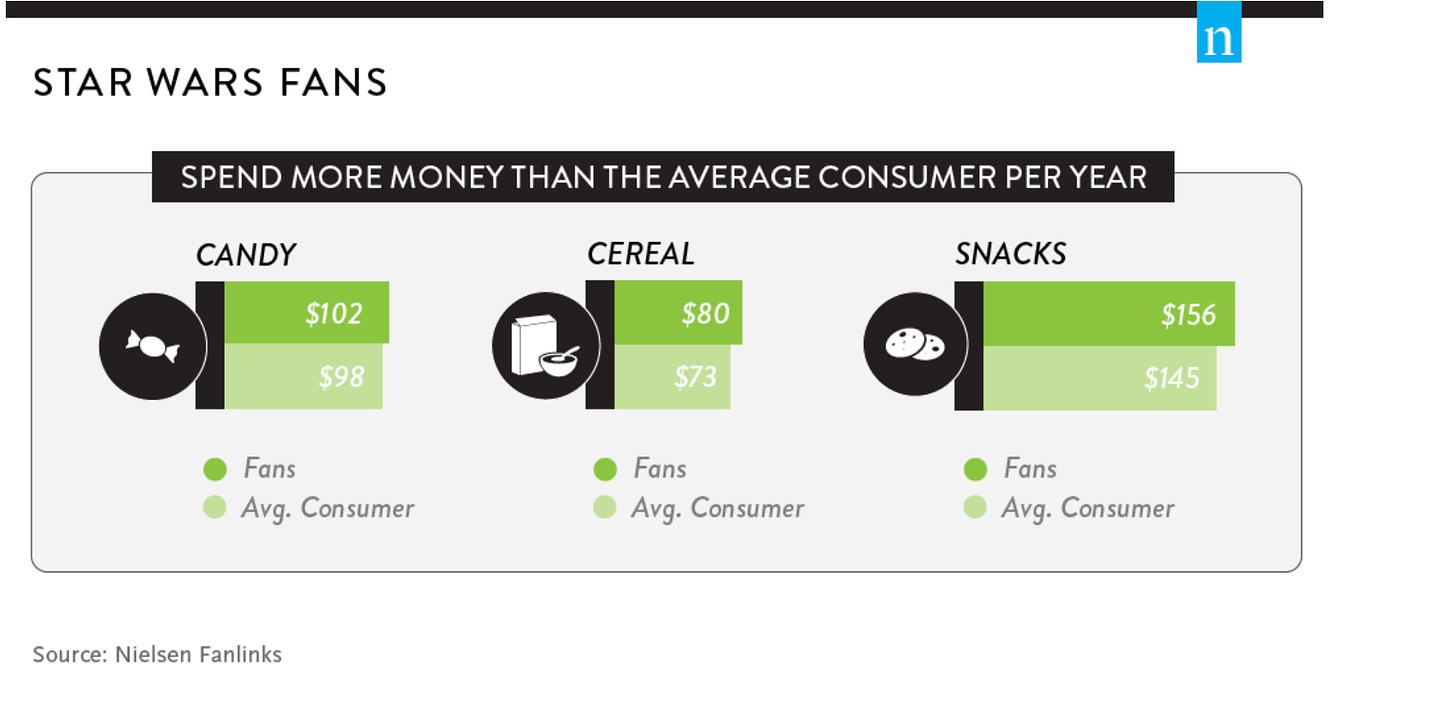
Source: Nielsen.
I find this analysis fascinating for two reasons:
The data here highlights nominal differences in spending behavior. A $4 increase in annual candy spending amounts to roughly 1.5 candy bars.
It's astonishing that this research was commissioned at all. Nielsen, arguably the world's best-known media analytics firm, likely charged (or spent) thousands of dollars to conduct this study. Many adults likely worked on this, and only this, for several weeks. And why was this project worthwhile? Because Star Wars is central to contemporary culture.
Since acquiring Star Wars in 2012, Disney has sought to capitalize on the dedication and (quantifiable) buying power attached to this media property, releasing four films and launching countless streaming series. As a result, Star Wars content production has increased exponentially over the past decade as franchise expansions have become the cornerstone of Disney+ programming.
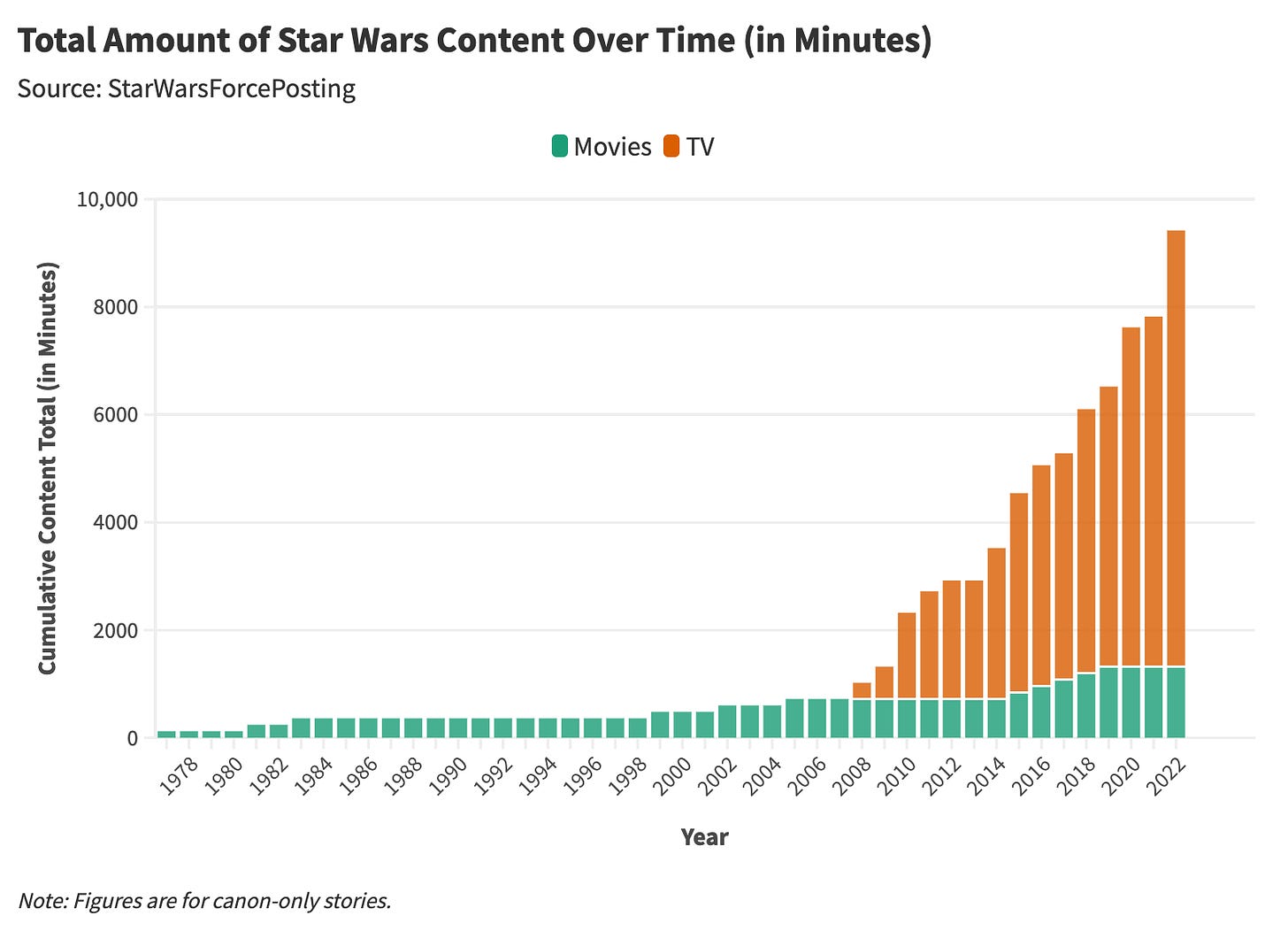
Disney's proliferation of Star Wars content has been met with mixed reactions. Some shows and movies have done right by the franchise ("The Mandalorian" and The Force Awakens), while others have spurred frustration ("The Acolyte" and The Last Jedi). That said, many fans (likely most fans) are probably unconcerned with passing judgment on these world-expanding installments—they're just happy to see new iterations of the thing they love.
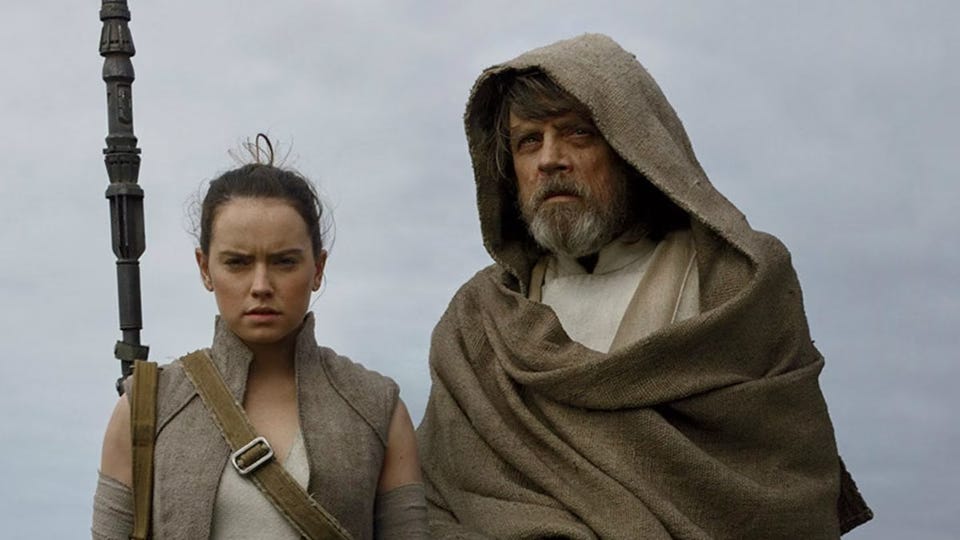
Star Wars: The Last Jedi (2017). Credit: Walt Disney Studios.
While nothing compares to the original trilogy, it appears one's estimation of franchise installments is heavily driven by age. Those born in the 1960s and 1970s have a higher appraisal of the original films (compared to younger cohorts), while those born in the 1990s and 2000s are more likely to enjoy the sequels and prequels (compared to older cohorts).
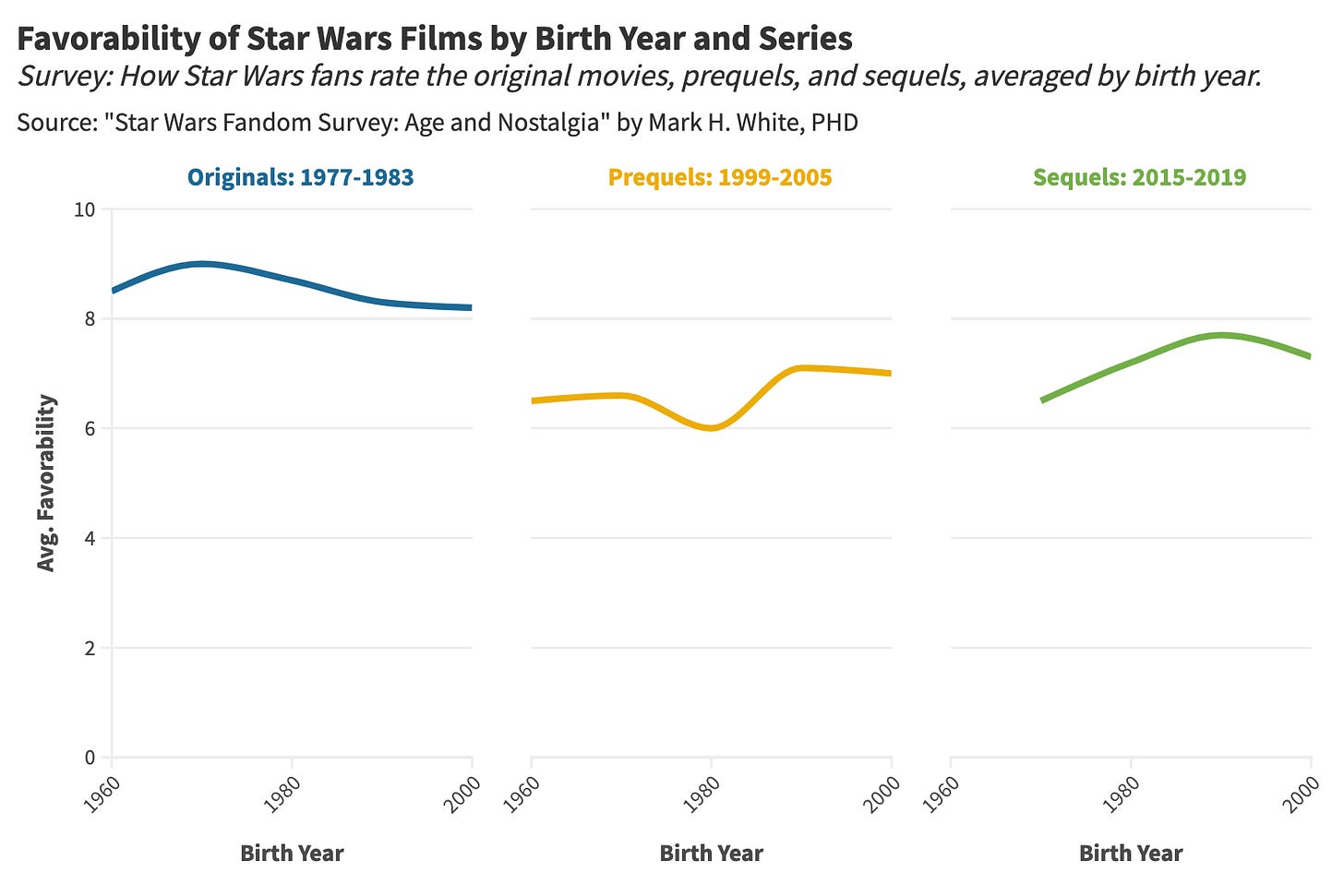
A separate study of fandom across generations from Rasmussen Reports found that those ages 19 to 39 find Disney's Star Wars films "better" than the originals, while those ages 40 and above are more likely to consider Disney installments "worse" than the early films. Each generation may feel more connected to their contemporary Star Wars, with the exception of The Phantom Menace and Jar Jar Binks.
In 2020, "The Mandalorian" premiered on Disney+ during the dark days of the pandemic and became an instant cultural phenomenon. According to Parrot Analytics, the first season of this series was watched 48 times more than the average streaming title, making it Disney's most-viewed streaming property to date. Over the next four years, Disney would double down on streaming content, releasing a barrage of Star Wars series, some good and some bad.
This influx of content has led to claims of "Star Wars fatigue." According to these critiques, Star Wars has benefitted from scarcity, especially in the 16 years between Return of the Jedi and The Phantom Menace, and recent overexposure has diluted brand value and made each subsequent release less significant. Disney's recent stewardship of the Star Wars franchise has seen numerous missteps, provoking backlash or disinterest from fans, proof that diehard fandom has its limits:
2018's Han Solo prequel (entitled Solo) lost a reported $77M—the first Star Wars film that wasn't an unqualified box office success.
A non-trivial segment of Star Wars fans are pretty unhappy about this year's "The Acolyte" and have subsequently review-bombed the show (inundating online sites with low user ratings). The reasons behind this online hostility could warrant a standalone article (or series of articles), so feel free to "Google it" if you're craving Acolyte controversy.
Disney's longtime CEO, Bob Iger, has admitted that the studio released "too many" Star Wars movies "too fast."
These blunders could spell disaster for Star Wars' future, or this could be a series of meaningless data points—disparate outliers conceivably interpreted as the beginning of the end for a storied franchise. Disney is an easy punching bag for media outlets, so why not throw a few grenades at a corporation that cares little about your measly words? Will Star Wars overexposure lead to its own version of "superhero fatigue," suffering a fate similar to Marvel circa 2023, or will these concerns be forgotten minutes after Disney's next hit?
A recent study revealed a three-year decrease in online sales for Star Wars products—yet another proof point for those in search of Disney schadenfreude. This decline could indicate the erosion of Star Wars fandom, or it could be noise.

Source: Pattern.
Personally, I believe franchises go through ups and downs, much like any long-running media property. In Marvel's case, Disney took a year off from superhero releases and (perhaps inadvertently) cultivated a newfound sense of scarcity for superhero fare. Now, the forthcoming Deadpool & Wolverine is the most anticipated movie of the summer. All Disney had to do was not create content (pretty wild).
Star Wars fandom thrived between 1983 and 1999—a period with no theatrical releases or TV shows. Maybe the Star Wars extended universe needs a brief vacation to reinvigorate its fanbase.
Final Thoughts: The Duality of Fandom
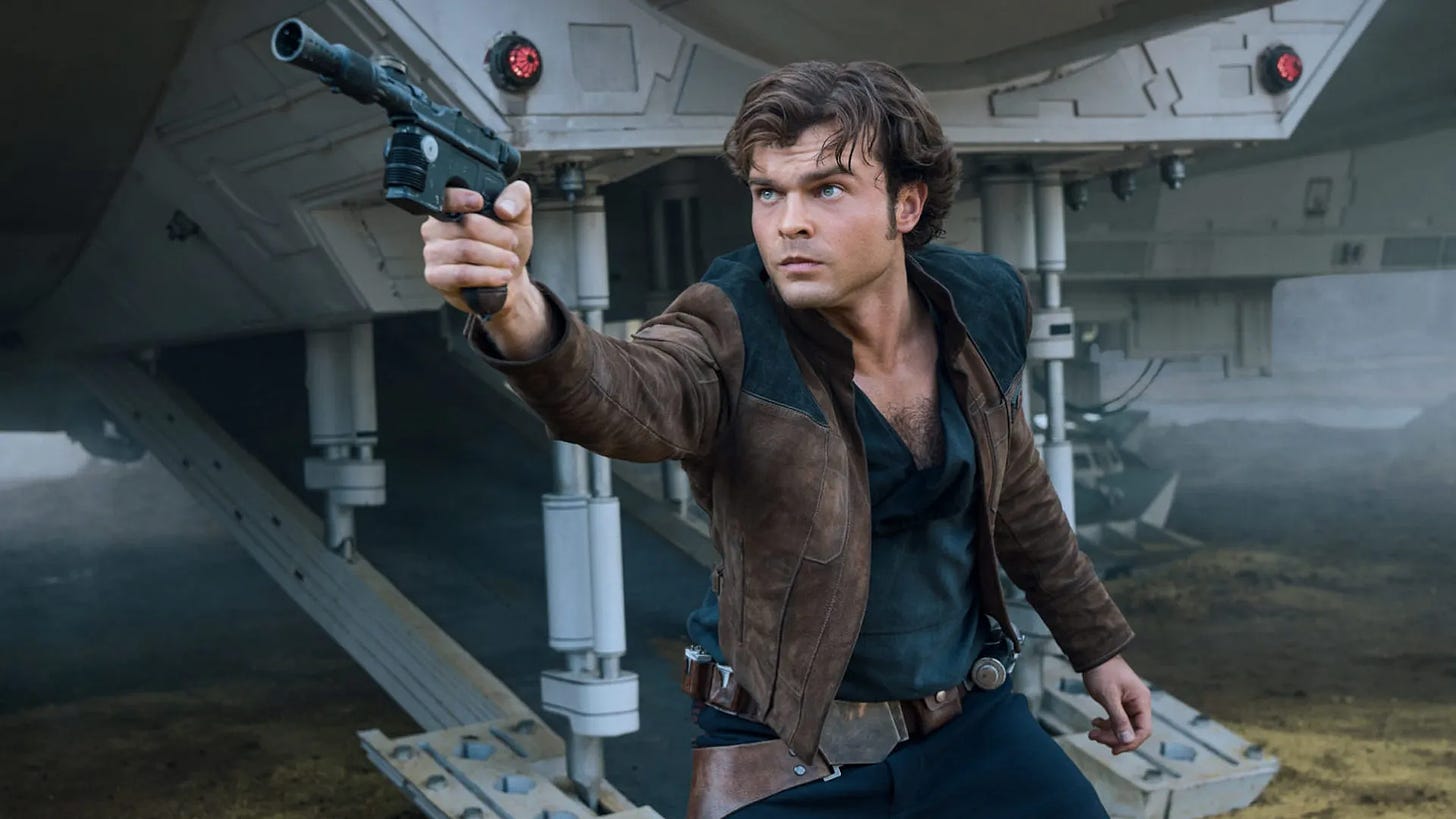
Solo: A Star Wars Story (2018). Credit: Walt Disney Studios.
My primary frustration with Star Wars fandom (and most other fandoms) lies in the juxtaposition between childhood wonder and commercial interest.
Childhood Wonder: My dad first showed me Star Wars during early adolescence. He wasn't trying to entangle me in Disney's IP maximization strategy or set me on a treadmill of endless paraphernalia consumption—he just wanted to show me a thing he loved. As a six-year-old, I had little understanding of what loving A New Hope and Return of the Jedi might entail twenty years later—how I might become a data point in a meaningless Nielsen analysis on candy spending. I just thought, "Wow, this movie rocks and I'm so happy to be sharing this experience with my dad."
Commercial Interest: Disney's business—from movies to parks to merchandise—is built upon extracting economic value from intellectual property. From Mickey Mouse to Inside Out 2's Anxiety, this corporation covets copyright protections over iconic characters, songs, and objects. If your child likes Baby Yoda, congratulations—you will now spend $100 on Baby Yoda dolls, t-shirts, stickers, and costumes. And you have no choice in this matter—why would you want to deprive your six-year-old of something they love? Thirty years from now, Baby Yoda will be reworked into a Star Warsreboot, and your child (now an adult) will have no choice but to buy this merchandise for their kid. One six-year-old's preoccupation with an adorable green Jedi may spawn a generational cycle of fandom.
Most people won't contemplate the economic implications of their Star Wars, Moana, or Marvel fandom and how loving these characters may intersect with Disney's Q4 earnings. And you know what? That's probably for the best.
If you're excited about new Star Wars shows, movies, and merch, then good for you—you've retained a sense of childlike wonder. You're not bogged down by meaningless cynicism.
If you're reading this and grumbling about the state of the entertainment industry and its overreliance on IP, then I'm sorry. You can bookmark this article in a folder entitled "Proof of our dying culture" and then continue scouring the internet for evidence of how everything is worse (and the internet will be happy to oblige).
I wish I could go back to Sunday screenings with my dad and watch Star Wars without disillusionment, perfectly content with franchise reboots, and absent my fixation on Disney's corporate strategy—but I can't. And you know what? That stinks.
Thanks for reading Stat Significant! Subscribe for free to receive new posts and support my work.
Want to chat about data and statistics? Have an interesting data project? Just want to say hi? Email [email protected]